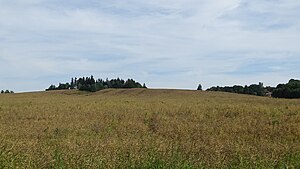Stadtberg (Neusalza-Spremberg)
| Stadtberg | ||
|---|---|---|
|
Lindenberg (middle) and Stadtberg (right) |
||
| height | 367.5 m above sea level NN | |
| location |
Germany , Saxony ( Görlitz district ) |
|
| Mountains | Upper Lusatian highlands | |
| Coordinates | 51 ° 1 '51 " N , 14 ° 31' 52" E | |
|
|
||
| rock | granite | |
The Stadtberg is - as the name suggests - the Stadtberg of Neusalza-Spremberg in the district of Görlitz in Saxony . With a height of 367.5 m above sea level. NN the mountain is one of the smaller elevations of the small Saxon town.
Location and name
The Stadtberg is located outside the center of Neusalza-Spremberg on Rumburger Strasse, which leads to the Neuspremberg district , in the immediate vicinity of the Zittau-Dresden railway line . In the 19th century the mountain was also called "Windmühlenberg" or Höllberg (map from 1821 to 1822) because of a windmill there, and in the first decades since the young town of Neu-Salza was founded (1670) it was called "Galgenberg" because the municipal execution site (gallows) was located there.
Geology and geography
The lightly wooded granite mountain, covered with a loess clay cover, breaks off steeply on its north side, while its other sides gradually run out into the terrain as arable land. In a westerly direction, its ridge coincides with that of the almost equally high "Lindenberg" ( 370.5 m above sea level ). The profile of the northern slope suggests that gravel was once mined here. Below the north-east side of the mountain on Rumburger Strasse are two residential buildings, and two buildings on its plateau.
history
After the exile town of Neu-Salza was founded in 1670, today's Stadtberg was elevated to a place of execution because of its exposed location away from the town towards the Bohemian border. The gallows stood visible on the mountain. In the local history of the small town, three executioners by name and four executions that were carried out by them in Neusalza and Lawalde can be traced between 1670 and 1706 . Two executions were carried out in the Electoral Saxon town with the sword in 1697 on the Obermarkt and with the strand 1700 on the Galgenberg, the other two in the village of Lawalde also by hanging. The executed were a murderer and false executioner journeyman and, on the other hand, thieves who haunted Lawalde and Löbau . The gallows later fell into disrepair, but the macabre name of the mountain stuck in the minds of the locals for a long time.
In the 19th century a Dutch windmill with a bakery adorned the Stadtberg. The mill burned down in 1888. A larger villa-like building on the top of the hill built after the First World War - today a residential building - was a “Maidenheim” during the time of National Socialism in Germany. In GDR times the building belonged to a unit of the German Border Police (DGP) until the 1960s as a so-called "Grenzerhaus" , later border troops of the GDR, which were initially stationed in Turnerstrasse in Neusalza-Spremberg. From the Stadtberg, the Neusalza-Spremberg border section, known as the “ border forest ”, to the former ČSR , now the Czech Republic , could be optimally controlled.
literature
- Lutz Mohr : Neusalza-Spremberg and its monuments. About bizarre natural structures and stone witnesses of local history . In: History and stories from Neusalza-Spremberg, volume 4. Neusalza-Spremberg: Kultur- und Heimatfreunde eV 2011.
- Lutz Mohr: Neusalza-Spremberg. A small town in Upper Lusatia. Highlights from history and legend . Special edition No. 1/2012 of the series: History and stories from Neusalza-Spremberg. Greifswald u. Neusalza-Spremberg: self-published 2012.
- August Adolph Tuchatsch (Ed.): Historical news about the city of Neu-Salza ... Ceremony for the 200th anniversary of the city of Neusalza in 1870 . Photomechanical reprint: Neusalza-Spremberg: Michael Voigt 2000.



